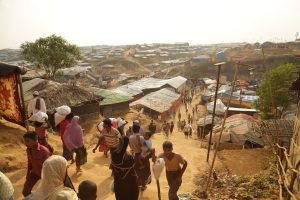As Ukraine dominates global attention and funding, it almost feels like the rest of us are competing for crumbs. In Cox’s Bazar, where I work in the Rohingya response, refugees tell us they feel forgotten by the world, and they are not wrong.
Five years since fleeing the threat of genocide, almost 1 million people remain completely aid-dependent, neither legally recognized as citizens of Myanmar, the country that drove them out, nor legally considered as refugees by Bangladesh, the country that currently hosts them.
Many refugees around the world live in cities or in temporary homes with solid walls. The Rohingya do not. The “largest refugee camp in the world” is located in Teknaf and Ukhiya, where shelters made of bamboo and tarpaulin often stand on steep hill faces, crowded together so densely that any semblance of privacy is impossible.
Each of the last five years of the Rohingya exodus has been an exercise in rebuilding and loss. In the dry months, fires frequently sweep through the camps, tearing through flammable bamboo and destroying everything in the flames’ path. In the summers, rains batter the tarpaulins, flooding shelters and causing life-threatening landslides. Here, between the fire and the flood, lives have stagnated. There are no jobs, everyone is in debt, and no one can see a way out. The loss is communal, the hopelessness pervasive.
Prolonged deprivation amplified by two years of COVID-19 has produced a noxious mix of desperation and dread. Child marriages are increasing, abuse and assault have skyrocketed, and women and girls consistently report feeling unsafe and unsupported. At a time when protection programming should be expanded, funding cuts mean that many of our partners have been forced to slash their protection programs by half. On the ground, that means fewer women-friendly spaces, fewer learning facilities for girls, and fewer support systems for survivors.
As a last resort, some refugees are taking to the sea. But here too, in one country after another, the Rohingya are being turned back, incarcerated, or forcibly repatriated – all in clear violation of international law. Despite global compacts and grand commitments to protect humans forced to flee, wherever the Rohingya turn to for safety, the doors seem to slam shut.
To make matters worse, the ripple effects of the crisis in Ukraine have not spared Bangladesh. Disruptions in supply chains mean the cost of getting aid to communities has increased at a time when pledged funds are being diverted to regions of “greater concern.” Right now, of the $881 million needed to respond to the needs of Rohingya refugees in Bangladesh, only 13 percent has been funded, amounting to less than 30 cents per refugee per day. Meanwhile, suppliers are pulling out of framework agreements because the price of everything has gone up overnight, and agencies are struggling to keep essential programs afloat.
None of this should be normalized. Taking food from the hungry to feed the starving is not good enough. The diversion of funds from one crisis to another elevates the suffering of some above the desperation of others.
But the problem runs deeper than a sudden dip in funding. Aid can be a part of the solution to displacement, but it cannot be the sum total of our intervention. The political crisis that resulted in the exodus of a million people requires a political solution, but indifference and inaction by regional leaders mean that the Rohingya in Bangladesh are farther away from home than they were five years ago. This indifference, too, spans decades. Generations of Rohingya have asked the world for the bare minimum – a fair shot at a future – only to be turned away, time and time again.
The solutions are complex, but not impossible. In an era of staggering levels of displacement, if the cost of aid is increasing as available funding dissipates, donors must share the responsibility of ensuring humanitarians are able to do more with less. Beyond passive observation, donor representatives must join us to actively negotiate access, promote principled aid delivery, and lobby to ensure large demographics do not remain excluded from humanitarian programming. The governments they represent must lead the charge for political interventions in service of durable solutions.
Specifically, lobbying to remove arduous bureaucratic barriers to operations will increase “value for money,” but donors can, and should, also push the envelope on “old innovations” like cash transfers, which greatly reduce the cost of aid while giving people the freedom to make their own choices. At the very least, multi-year, flexible funding needs to become the norm and not the exception. Too many grants continue to be “fixed plans” limited to 12 months, when the reality on the ground changes almost every day. Too much time is being spent on inane paperwork when the focus needs to be on implementation, inclusion, and quality of programming.
Refugees in Bangladesh do not have a choice, but we do. This World Refugee Day, we should recommit to forging a global coalition of solidarity and action to support Rohingya refugees, and ensure that 1 million people have a future worth believing in. Or, if that is too hard, we can accept the charge of inaction and admit what refugees in Cox’s Bazar already know – that despite global commitments, not all refugees are treated equally, not all refugees have the same rights, and not all refugees are supported to inform the decisions that shape their lives.
Some refugees get to return home; others are condemned to a life in limbo.

































